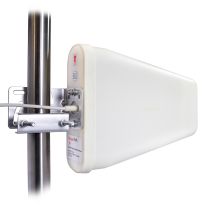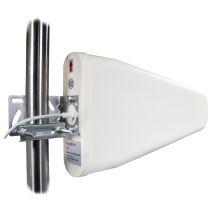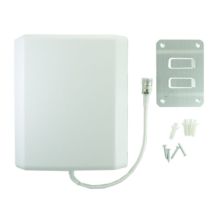
- Correctly align the external antenna of LTE repeater
- How can you find the best outdoor signal?
- Find the nearest transmission tower in your area
- Sufficient distance/mass between the indoor antenna and the outdoor antenna
- What is feedback?
- Solutions when the distance to the outdoor antenna is insufficient
- Solutions when there is no ground between the outdoor and indoor antenna
- Other possible solutions on how to properly install the outdoor antenna
- Fixing and orientation of the outdoor antenna
For 4G/LTE signal reception with a 4G/LTE repeater, it is very important to properly place and install the outdoor LTE antenna, of which high quality is required. Also, it is important to place the outdoor antenna where the outdoor 4G/LTE signal is best. The LTE repeater can only work if there is at least a minimum of 4G/LTE signal outdoors: for example, if there is no outdoor 4G/LTE signal, it could not be guaranteed to be amplified indoors, as there would be no signal to amplify.
Your repeater's outdoor LTE antenna is the most important part of the whole kit, so it is important that proper installation and alignment is done with the transmission towers of the cellular carriers you are interested in. By following a few simple rules outlined below, you can get tips for the proper operation of your LTE repeater.
1. Correctly align the external antenna of LTE repeater
This is the secret to proper operation: do a test installation of your LTE repeater!
Then you can channel the coaxial cables of the outdoor LTE antenna.
Align the outdoor LTE antenna with the 4G/LTE transmission towers of the cellular carriers you are interested in. Run the coaxial cable through a window or air duct, connect the cable to the LTE repeater, and plug in the power cord. Then turn on the LTE repeater to check that everything is working properly.
LTE reception is working well! This means that the position/direction of the outdoor LTE antenna is correct. At this point you can turn off the LTE repeater and channel the coaxial cable permanently.
Done, your LTE repeater is working and the outdoor LTE antenna is installed correctly!
Is the LTE reception not good? It means you need to find a location, a better alignment for the outdoor LTE antenna.
2. How can you find the best outdoor signal?
With your cell phone you can measure the strength of the external 4G/LTE signal: you can see the exact value of the LTE signal, expressed in dBm, in negative value. You can find out how to do this by reading more in our blogs, as shown below.
Note: Since this is a negative scale, the best external signal is indicated by the lowest number (with the minus in front). For example, -46 dBm is much better than -102 dBm.
As shown in the following image, it is advisable to perform multiple tests of the outdoor signal at different locations/heights until you find the point where the signal is best. In the example shown, the best point would be at point E, where you have the best 4G/LTE reception. We also recommend testing the signal as high as possible, such as on a rooftop and, of course, where you can connect an outdoor LTE antenna.
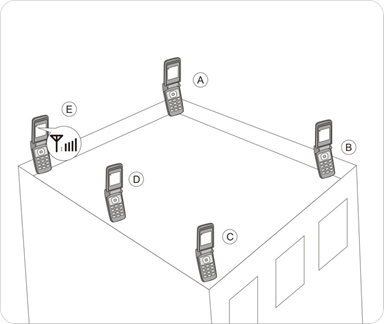
Visit these two blogs to check how to test outdoor signal with Android, how do I measure the mobile signal with Android or iPhone, how do I measure the mobile signal with iPhone.
3. Find the nearest transmission tower in your area
The outdoor LTE antenna must be directed to the right broadcast tower to receive the signal correctly. It is therefore important to locate the nearest LTE transmission tower. Ideally, the LTE transmission mast is visible, in view and without any particular obstacles in the way.
In rural areas, directional 4G/LTE antennas (Yagi Logarithm and Yagi Super Logarithm) are often used as a type of outdoor antenna since there are fewer transmission towers and/or vegetation is denser, causing a reduction in the available mobile signal. In fact, it should be kept in mind that forests, trees and tall buildings have a great influence on the reception of LTE mobile signal.
In urban areas where there are many LTE towers, it is more common to install an outdoor LTE panel antenna. Because the outdoor LTE panel antenna can pick up signals over a larger area, the alignment of the outdoor LTE antenna is easier here.
You can easily find LTE broadcast antennas on the Internet by locating your location using the platform below, for example:
You can also use apps to locate LTE transmission towers, such as NetMonitor Cell Signal Logging.
4. Sufficient distance/mass between the indoor antenna and the outdoor antenna
If the outdoor LTE antenna and the indoor antenna come into communication with each other, your LTE repeater will not work properly or at all.
For your safety, the LTE repeater signals this interference.
An LTE repeater is a radio system that receives the LTE signal, amplifies it, and sends it to the indoor antenna that broadcasts the signal in a given area.
If the outdoor LTE antenna is installed too close to the indoor antenna, the signal sent by the indoor antenna will also be partly picked up by the outdoor antenna, which will send it back to the indoor antenna, I believe a signal loop, and thus interference (self-oscillation phenomenon).
Think of it as a music system: if you hear a hum, it is because the microphone picks up sounds from the speakers, sounds that are then relayed back from the speakers and the microphone picks them up again, etc.
In the case of LTE repeaters we talk about self-oscillation rather than feedback as in the music field, but it is the same principle, with the same consequences, interference
Your LTE repeater has automatic LTE signal control, which automatically adjusts the gain. You can manually attenuate the amplification, but the consequences will be that your LTE repeater will operate at reduced power.
Let's take feedback from a music system again as an example: when you hear a buzzing sound, you can turn the volume down to stop it, but after a while, if you turn the volume down too much, there is no more sound for the audience! So the solution is to increase the distance between the microphone and the speakers to avoid feedback.
The same rule applies to an LTE repeater: you need to increase the distance between antennas or isolate the outdoor LTE antenna and the indoor LTE antenna, one from the other, more.
5. What is feedback?
If the outdoor and indoor LTE antenna are installed in such a way that they communicate with each other, your LTE repeater will not be able to sense the 4G/LTE signal. In this case it will go into self-protection mode until it reboots (and until the interference disappears). In the image below you can see the effect called self-oscillation or feedback:
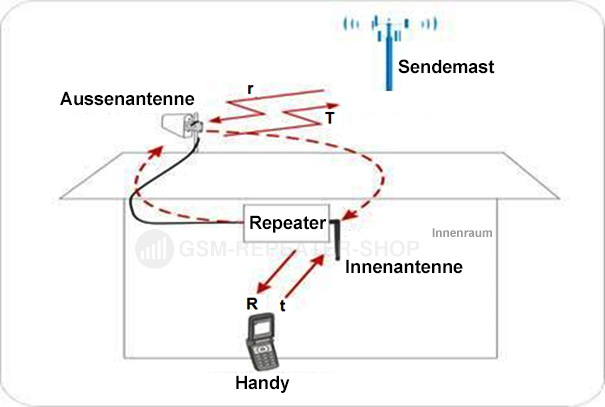
As shown above, the outdoor LTE antenna receives the downlink signal (r) from the LTE transmission tower and sends it to the LTE repeater. The newly amplified signal (R) from the repeater (or amplifier) is then sent to the cell phone via the indoor LTE antenna.
If the distance between the outdoor LTE antenna and the indoor antenna is not enough, the amplified LTE cell phone signal sent by the indoor LTE antenna (R) is picked up again by the outdoor LTE antenna.
This can be prevented by following the following recommendations, taken individually or together:
5.1 Solutions when the distance to the outdoor antenna is insufficient
Install the outdoor LTE antenna as far as possible from the indoor antenna. It is generally assumed that there should be a distance of at least 10 meters between the outdoor LTE antenna and the indoor antenna for adequate feedback prevention.
We supply each amplifier equipped with a 10-m coaxial cable so as to avoid feedback.
If you need a longer coaxial cable, click here and you will find a wide selection of coaxial cables.
When installing LTE repeaters with multiple indoor LTE antennas, it is usually the indoor antenna closest to the outdoor LTE antenna that is responsible for feedback.
Of course, it can also happen that although the distance is optimal, feedback occurs. In this case, it is necessary to check whether there are windows, canopies, wooden panels, grills, or other openings permeable to radio waves near the antennas that could be responsible for the feedback.
If everything turns out to be installed correctly, then you should opt for more isolation between outdoor antenna and indoor antennas through ground.
5.2 Solutions when there is no ground between the outdoor and indoor antenna
We call "building mass" any material that does not (or only minimally) allow the passage of mobile signal radio waves. For example, metal panels, concrete walls or ceilings, very thick walls of old buildings, lead sheets, metal grids, or even wire mesh attached to the floor.
It is important to have sufficient structural dimensions to allow isolation between the outdoor LTE antenna and the indoor antenna and thus to avoid feedback.
5.3 Other possible solutions on how to properly install the outdoor antenna
The above two solutions (distance and size) can be perfectly combined to create the best possible isolation of the outdoor LTE antenna and the indoor antenna in order to avoid feedback.
Some examples for better understanding:
- Usually even about 6 meters distance between the outdoor LTE antenna and the indoor antenna, but even 2 carrier walls, should be sufficient to avoid feedback.
- Hypothetical situation: outdoor LTE antennas and indoor antenna at the same level, but 10 meters apart, with 2 doors in between: Feedback is unlikely, but still possible because of the doors (e.g., if the doors are wooden or stay open all the time).
- Another solution is to install the outdoor LTE antenna in such a way that all the indoor LTE antennas are in the back relative to the outdoor antenna. If, for example, the outdoor LTE antenna is oriented to the north and all the indoor antennas are to the south of the outdoor antenna, then there will be no danger of feedback.
6. Fixing and orientation of the outdoor antenna
Depending on the type of outdoor LTE antenna you received with your LTE repeater, you need to pay attention to some issues:
6.1 Properly install and secure the outdoor LTE antenna
This process is extremely quick and easy because the mounting plate and its screws already come with the outdoor LTE antenna. All you need is a flat wrench or universal pliers.
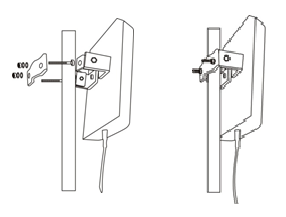
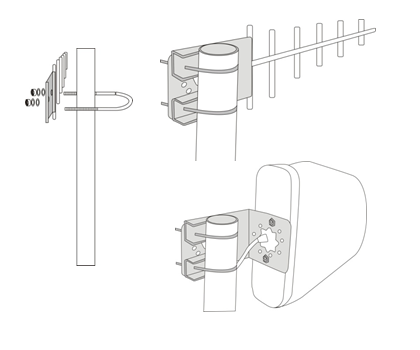
6.2 Mount the outdoor LTE antenna correctly
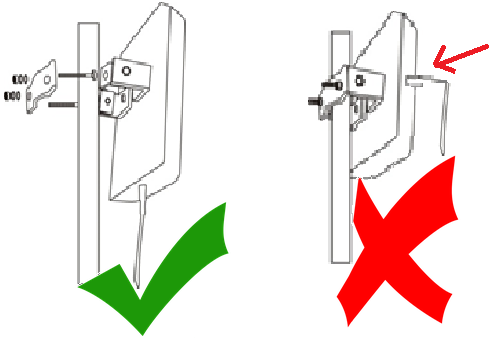
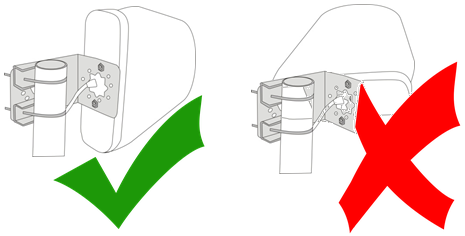
If the outdoor LTE antenna is a directional LTE antenna (Yagi Logarithm or Yagi Super Logarithm), you should consider the direction of the red arrow on the back for proper condensate flow. The red arrow should point upward as shown in the drawing below:

6.3 Properly align the outdoor LTE antenna with the transmission tower
The large plastic surface of the outdoor LTE panel antenna is the "receiving area" of the LTE antenna: this is where the LTE signal is received.
This part should be aligned in the direction of the nearest transmission tower.
With LTE directional antennas, the tip of the outdoor LTE antenna should always be oriented toward the LTE transmitting tower.
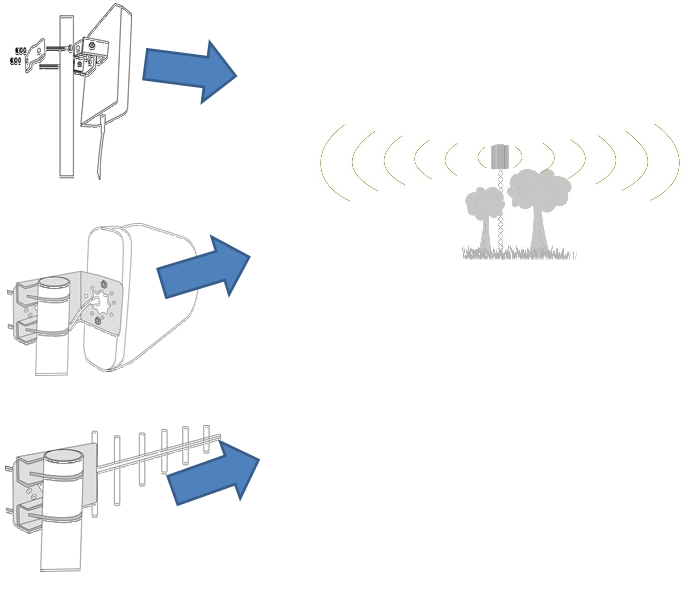
6.4 Limitations of the outdoor antenna
This is especially important for the LTE directional antenna of the Yagi type. In any case, the tip of the outdoor LTE antenna must point toward the transmission tower so that the signal can be received.
There should be as few topographical and structural obstacles as possible between the LTE directional antenna and the LTE transmission tower but often this cannot be avoided. It is recommended that the outdoor LTE antenna be installed as high as possible to ensure the best possible performance of the antenna.
It is important that the outdoor LTE signal be tested well in advance. If the outdoor signal is very weak, it will be necessary to use a more powerful outdoor antenna. Simple rule: the weaker the outdoor signal, the more powerful the outdoor antenna must be.
6.5 Features of the outdoor panel antenna
As for the outdoor panel antenna, alignment is less critical than for LTE directional antennas, but the panel antenna should always be connected as close as possible to the received mobile signal.
If you are not sure where the strongest LTE mobile signal is coming from, in addition to contacting us, you can try rotating the antenna bracket (around its mounting axis) until the strongest signal appears on the LTE repeater.
Because each type of outdoor LTE antenna has its advantages and disadvantages, it is sometimes difficult to make the right choice.
